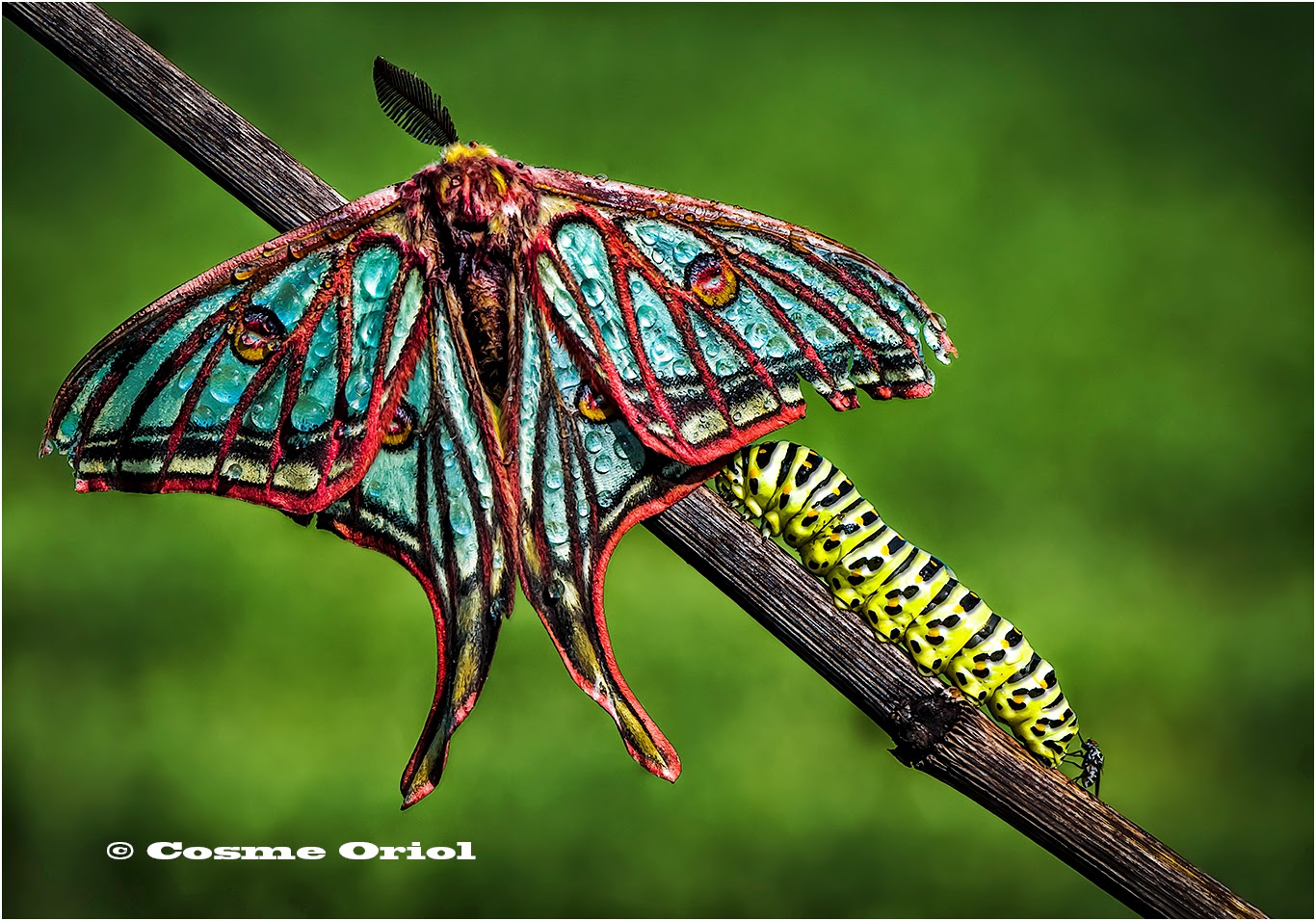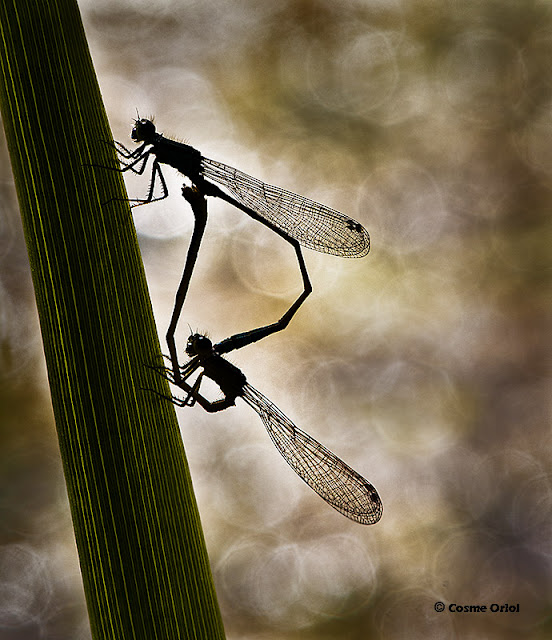ESTE BLOG TIENE COMO OBJETIVO INTERCAMBIAR EXPERIENCIAS Y CONOCIMIENTOS FOTOGRÁFICOS, DESDE LA CAPTURA DE LA IMAGEN A SU ACABADO. //////// AQUEST BLOC TÉ COM OBJECTIU INTERCANVIAR EXPERIÈNCIES I CONEIXEMENTS FOTOGRÀFICS, DES DE LA CAPTURA DE LA IMATGE AL SEU ACABAT. /////// THIS BLOG IS INTENDED TO SHARE EXPERIENCES AND KNOWLEDGE PHOTO FROM CAPTURING THE IMAGE TO FINISH.
viernes, 23 de enero de 2015
NUEVAS FOTOS 2015 - 1er. TRIMESTRE / NOVES FOTOS 2015 - 1er. TRIMESTRE
PROVES DEL MEU NOU SISTEMA DE PROCESSAMENT / PRUEBAS DE MI NUEVO SISTEMA DE PROCESADO / TEST MY NEW PROCESSING SYSTEM.
jueves, 1 de enero de 2015
MACROFOTOGRAFIA / NANOPAISATGE / MINI LANDSCAPE
FOTOGRAFÍAS DEL PEQUEÑO MUNDO ANIMAL QUE NOS RODEA, TAN DESCONOCIDO COMO INADVERTIDO
VIVIMOS RODEADOS DE VIDA, Y NO ÚNICAMENTE HUMANA, SÓLO TENEMOS QUE POTENCIAR Y AGUDIZAR NUESTROS SENTIDOS PARA DESCUBRIRLA
Desde siempre me he sentido atraído por la MACROFOTOGRAFÍA; pero fue en 2011 cuando después de participar en un taller realizado en Afotmir e impartido por el compañero especialista del tema: Isidro Humet, tomé la decisión de incluir en mis trabajos habituales esta temática fotográfica,.
Aparte de las satisfacciones fotográficas, la macrofotografía, me ha supuesto ser más observador y paciente, además de aprovecharme de los beneficios que supone estar mucho tiempo entre la naturaleza y que nunca antes había experimentado y vivido tan intensamente.
Para obtener óptimos resultados, a parte de conocer la vida y los hábitos de estos animales, es más imprescindible que nunca la conjunción de las habilidades y conocimientos técnicos, con las aptitudes artísticas: enfoque preciso, profundidad de campo personalizada, pero reducida; luz natural directa o a contraluz y también de apoyo, ya sea natural o flash rebotado o / y de relleno.
También es esencial, asociar, la armonía cromática del sujeto con el entorno y el fondo, todo ello reforzado por la composición: punto de vista, perspectiva, colores y monocromías, etc, etc.
Con este tipo de fotografía, siempre intento potenciar más la parte artística que la de documento científico. Aunque decir artístico sea un poco pretencioso, ya que me da la sensación, que priorizo más el lado técnico al creativo, probablemente debido a mi formación académica y laboral.
Habitualmente, mi método de trabajo en campo, es el siguiente:
Utilizo una cámara Nikon D300 o D 800, con el objetivo Nikon 105mm / f: 2,8.
La apertura del diafragma la decido en función de la distancia entre el sujeto y el fondo:
. Además de 5 metros; pongo 11 o 16.
. Entre 0,5 y 1 metro, utilizo habitualmente una abertura de 8.
. A menos de 0,4 metros, he llegado a utilizar hasta f: 2,8
Siempre que puedo utilizo un trípode muy sólido, con un disparador a distancia.
Salgo a fotografiar a primera hora del día o últimas horas de la tarde; así la luminosidad es mejor y más controlable.
En OCASIONES utilizo el flash de relleno a la cortinilla trasera en EV entre -2 y -3; con apoyo de un reflector blanco o plateado.
El sistema de medición de la luz, lo decido en función del tipo de motivo, de su entorno y del fondo; con preferencia a la Prioridad en el Centro y la Matricial.
La velocidad de obturación, es de 1 / 250s.o superior; así, puedo congelar los posibles movimientos de los insectos que están parados (no en vuelo))
La ISO, en AUTOMÁTICO (máx. 3200)
Y siempre que puedo el enfoque es en AUTOFOCUS
Para el PROCESADO, utilizo de inicio el ViewNX2 de Nikon o / y el ACR; y finalmente PHOTOSHOP.
******
FOTOGRAFIES DEL PETIT MÓN ANIMAL QUE ENS ENVOLTA, TAN DESCONEGUT COM INADVERTIT
VIVIM ENVOLTATS DE VIDA, I NO ÚNICAMENT HUMANA, NOMÉS HEM DE POTENCIAR I AGUDITZAR ELS NOSTRES SENTITS PER DESCOBRIR-LA
Des de sempre m'he sentit atret per la MACROFOTOGRAFIA; però va ser el 2011 quan després de participar en un taller realitzat a Afotmir i impartit pel company especialista del tema: Isidre Humet, vaig prendre la decisió d'incloure en els meus treballs habituals aquesta temàtica fotogràfica.
A part de les satisfaccions fotogràfiques, la macrofotografia , m'ha suposat ser més observador i pacient, a més de aprofitar-me dels beneficis que suposa estar molt temps entre la natura i que mai abans havia experimentat i viscut tan intensament .
Per obtenir òptims resultats, a part de conèixer la vida i els hàbits o costums d'aquests animals, és més imprescindible que mai, la conjuminació de les habilitats i coneixements tècnics, amb les aptituds artístiques: enfocament precís, profunditat de camp personalitzada, però reduïda; llum natural directa o a contrallum i també de suport, ja sigui natural o flaix rebotat o / i de farciment.
També és essencial, associar, l'harmonia cromàtica del subjecte amb l'entorn i el fons, tot això reforçat per la composició: punt de vista, perspectiva, colors i monocromias, etc, etc.
Amb aquest tipus de fotografia, sempre intento potenciar més la part artística que la de document científic. Encara que dir artístic sigui una mica pretensiós, ja que em dóna la sensació, que prioritzo més el costat tècnic al creatiu, probablement a causa de la meva formació acadèmica i laboral.
Habitualment, el meu mètode de treball en camp, és el següent:
Utilitzo una càmera Nikon D300 o D 800, amb l'objectiu Nikon 105mm / f : 2,8.
L'obertura del diafragma la decideixo en funció de la distància entre el subjecte i el fons:
. A més de 5 metres; poso 11 o 16.
. Entre 0,5 i 1 metre, utilitzo habitualment una obertura de 8.
. A menys de 0,4 metres, he arribat a utilitzar fins f : 2,8.
Sempre que puc faig servir un trípode molt sòlid, amb un disparador a distància.
Surto a fotografiar a primera hora del dia o a últimes hores de la tarda; així la lluminositat és millor i més controlable.
En OCASIONS utilitzo el flaix de farciment a la cortineta posterior a EV entre -2 i -3; amb suport d'un reflector blanc o platejat.
El sistema de mesurament de la llum, ho decideixo en funció del tipus de motiu, del seu entorn i del fons; amb preferència a la Prioritat al Centre i la Matricial.
La velocitat d'obturació, és de 1/250s. o superior; així, puc congelar els possibles moviments dels insectes que estan aturats (no en vol).
L'ISO, en AUTOMÀTIC (màx. 3200).
I sempre que puc l’enfocament és en AUTOFOCUS.
Pel PROCESSAT, utilitzo d'inici el ViewNX2 de Nikon o / i el ACR ; i finalment PHOTOSHOP.
******
PHOTOGRAPHS OF SMALL ANIMAL WORLD AROUND US, SO AS UNKNOWN INADVERTENT
SURROUNDED LIVE LIFE, NOT ONLY HUMAN, WE HAVE TO PROMOTE AND ONLY sharpen our senses to discover
Since I have always been attracted by the Macro; but it was in 2011 when after participating in a workshop in Afotmir and taught by specialist subject companion: Isidro Humet, I decided to include in my daily work this photographic subject,.
Besides photographic satisfaction, macro photography, has led me to be more observant and patient, plus take advantage of the benefits of being a long time between nature and had never before experienced and lived so intensely.
For best results, apart from knowing the life and habits of these animals, it is more imperative than ever the combination of skills and expertise, with artistic skills: precise focusing, depth custom field, but reduced; direct natural light or backlit and support, whether natural or bounce flash and / or filler.
It is also essential, associate, chromatic harmony with the environment of the subject and the background, all enhanced by the composition: view, perspective, colors and monochromes, etc, etc.
With this type of photography, I always try to further enhance the artistic side that scientific document. Although artistic say it's a bit pretentious, as it gives me the feeling that I prioritize more technical to the creative side, probably because of my academic and professional training.
Usually my fieldwork method is as follows:
I use a Nikon D300 or D 800, aiming Nikon 105mm / f: 2.8.
The aperture's decided depending on the distance between the subject and the background:
. Addition of 5 meters; I put 11 or 16.
. Between 0.5 and 1 meter, I usually use an opening 8.
. Less than 0.4 meters, I have to use up f: 2.8
Whenever I can use a very solid tripod with a remote trigger.
I go out to photograph early morning or late afternoon; and the brightness is better and more controllable.
In OCCASIONS I use fill flash on the rear curtain between -2 and -3 EV; supported by a white or silver reflector.
The measuring system of light, I decide depending on the type of motive, their environment and background; in preference to the Priority Matrix Center and.
The shutter speed is 1 / 250s.o superior; well, I can freeze the possible movements of insects that are stopped (not in flight))
ISO to AUTO (max. 3200)
And whenever I can approach it in AUTOFOCUS
For PROCESSING, I use Start the ViewNX2 Nikon or / and ACR; and finally PHOTOSHOP.



******
SECUENCIA / SEQÜÈNCIA / SEQUENCE
CABALLITOS DEL DIABLO a la Conquista del Territorio /
ESPIADIMONIS a la Conquesta del Territori /
DAMSELFLIES IN CONQUEST LAND
RECONOCIMIENTO de la situación / RECONEIXEMENT de la situació / RECOGNITION of the situation
DIÁLOGO: PROPUESTA / DIÀLEG: PROPOSTA / DIALOGUE: A PROPOSAL
DIÁLOGO: NEGATIVAS / DIÀLEG: NEGATIVES / DIALOGUE: Negative
AMENAZAS / AMENACES / THREATS
INTIMIDACIÓN / INTIMIDACIÓ / BULLYING
EN GUARDIA / EN
GUÀRDIA / ON GUARD
RENDICIÓN / RENDICIÓ / SURRENDER
CONQUISTA / CONQUESTA / CONQUEST
CELEBRACIÓN / CELEBRACIÓ / CELEBRATION
EXALTACIÓN / EXALTACIÓ / THRILL
FESTEJOS finales / Gran CELEBRACIÓ / FAMILY
Suscribirse a:
Entradas (Atom)
















































































.jpg)


















.jpg)


.jpg)
.jpg)
+copia.jpg)
.jpg)
.jpg)



























